The Economics and Statistics Division maintains archives of previous publications for accountability purposes, but makes no updates to keep these documents current with the latest data revisions from Statistics Canada. As a result, information in older documents may not be accurate. Please exercise caution when referring to older documents. For the latest information and historical data, please contact the individual listed to the right.
<--- Return to Archive
For additional information relating to this article, please contact:
October 03, 2022HOUSEHOLD INCOME AND CONSUMPTION, Q2 2022 Household Income
In addition to compensation of employees, household income also includes net mixed income (generated from unincorporated businesses), property income received (generated as the result of ownership of assets) and current transfers received (generally from government).
In Q2 2022, Nova Scotia's household income was $12.45 billion or $26,904 per household. Nova Scotia's income per household amounted to 78.4% of the national average per household. The highest income per household was in Alberta and the lowest in Prince Edward Island (followed by Nova Scotia).
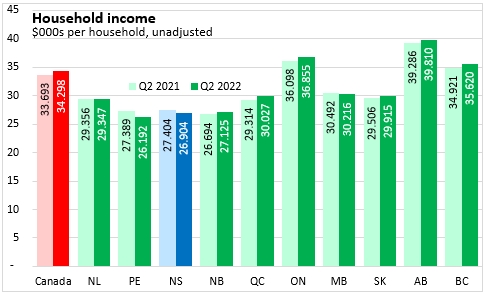
From Q2 2021 to Q2 2022, Nova Scotia's overall household income increased 4.2% (the number of households grew at a faster pace, so income per household contracted). National household income growth was 5.8% with the fastest growth in Ontario. All ten provinces reported rising household income. Manitoba reported the slowest household income growth among provinces.
In the first half of 2022, Nova Scotia's household income increased by 3.0% compared with the same period in 2021.

Nova Scotia's employee compensation was $7.13 billion in Q2 2022 or $15,411 per household (72.5% of the national average per household). Across Canada, employee compensation per household was $21,263. Alberta reported the highest employee compensation per household and Nova Scotia the lowest.

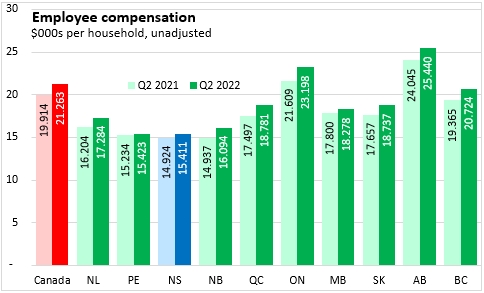
Nova Scotia's overall employee compensation was up 9.6% from Q2 2021 to Q2 2022. National employee compensation increased 11.0%.
Nova Scotia's employee compensation grew by 7.8% on average comparing the first half of 2022 with the same period in 2021.
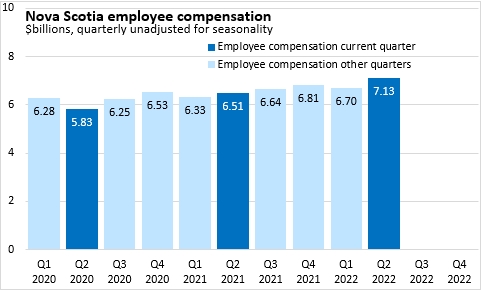
Net mixed income generated by unincorporated businesses amounted to $1.42 billion or $3,065 per household (94.2% of the national average per household). Across Canada, average per household net mixed income was $3,252 with the highest values in British Columbia and the lowest in Saskatchewan.
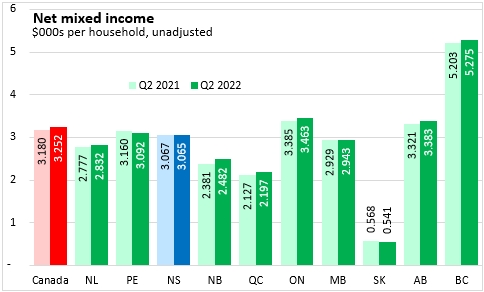
From Q2 2021 to Q2 2022, net mixed income grew by 6.1% (6.3% nationally).
Through the first half of 2022, Nova Scotia's net mixed income was up 4.7% compared with the same months of 2021.
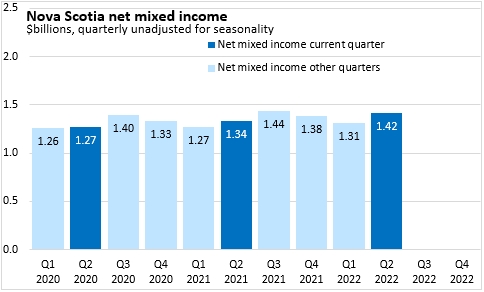
Nova Scotia property income received in Q2 2022 was $1.26 billion or $2,712 per household (77.3% of the national average). National property income per household was $3,510 with the highest values in Alberta and the lowest values in Newfoundland and Labrador.

From Q2 2021 to Q2 2022, property income receipts increased by 10.2% in Nova Scotia - slightly slower than the national pace of 10.6%.
On a year-to-date basis, Nova Scotia's property income receipts grew 7.6% comparing January to June 2022 with the same months in 2021.
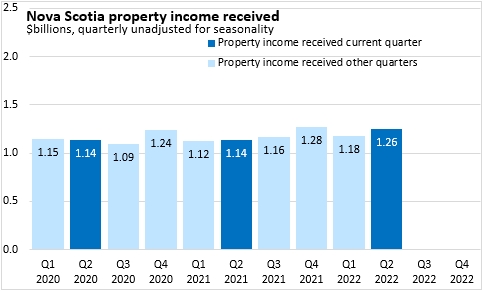
As many COVID-related support programs have been withdrawn, current transfers received in Nova Scotia were down to $2.65 billion or $5,716 per household in Q2 2022. Current transfers received in Nova Scotia were 91.1% of the national average per household ($6,273). Transfers per household were highest in Newfoundland and Labrador and lowest in British Columbia.
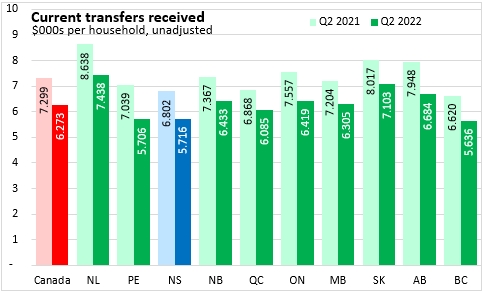
Compared with Q2 2021, the most recent quarterly transfer income received in Nova Scotia was down 10.8% (-10.6% nationally).
Year-to-date transfers received in Nova Scotia were down 9.9% compared with the first half of 2021.
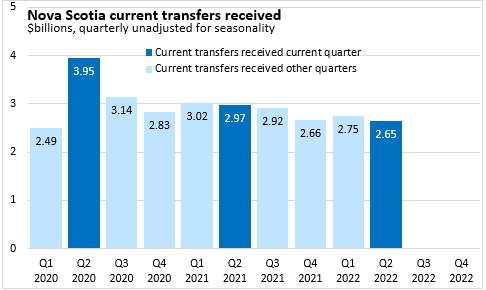
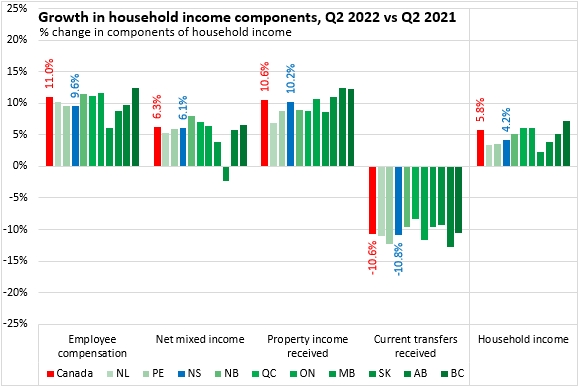
Household Consumer Expenditures
Nova Scotia's final consumer expenditures (paid for private by households) amounted to $9.44 billion in Q2 2022. This was $20,393 per household (88.0% of the national average per household). Across Canada, final consumer expenditures per household were $23,165 with the highest value in Alberta and the lowest in Quebec.

Between Q2 2021 and Q1 2022, final consumer expenditures increased by 13.8% (14.8% nationally), which includes the effects of price increases over this period.
On average over the first two quarters of 2022, Nova Scotia's household final consumer expenditures were up 12.5% over the same period in 2021.
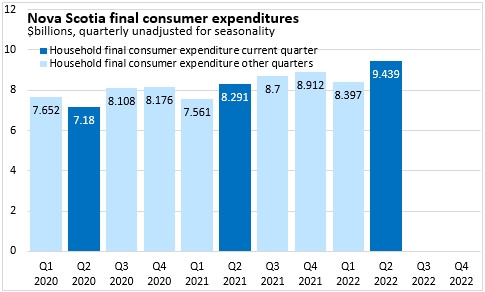
Social transfers in kind refer to services that are provided for the benefit of households but are paid for by governments and non-profits. These are primarily health and education expenditures, which add to private expenditures made on these services.
In Q2 2022, Nova Scotian households received $2.65 billion worth of social transfers in kind. This amounted to $5,722 per household (94.3% of the national average per household). Across Canada, social transfers in kind were $6,071 per household with the highest values in Manitoba and the lowest value in Prince Edward Island.
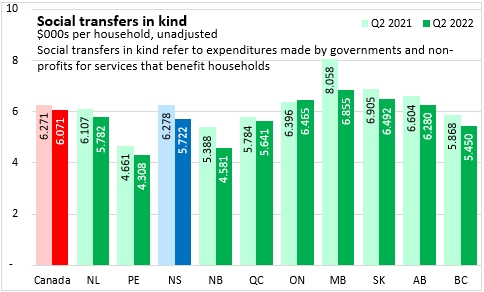
Between Q2 2021 and Q2 2022, the value of social transfers in kind in Nova Scotia decreased by 3.3% while there was a 0.7% increase nationally.
In the first half of 2022 (compared with the first half of 2021), Nova Scotia's social transfers in kind were up 0.7%.
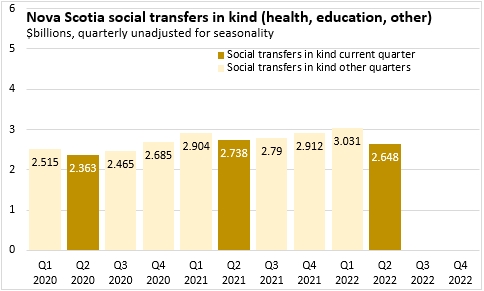
The sum of household final consumer expenditures and social transfers in kind is termed 'household actual final consumption expenditures', which reflects the benefits to households from both private expenditures as well as services provided by governments and non-profits.
Nova Scotia's household actual final consumption expenditures in Q2 2022 were $12.09 billion or $26,115 per household (89.3% of the national average per household). National household actual final consumption expenditures were $29,236 per capita with the highest value in Alberta and the lowest value in Prince Edward Island.
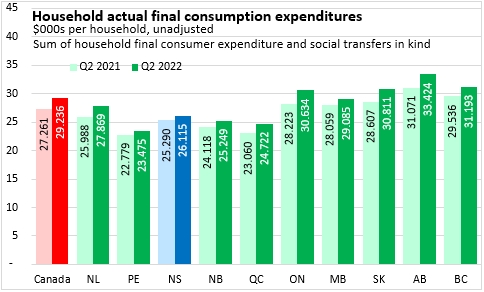
From Q2 2021 to Q2 2022, household actual final consumption expenditures increased by 9.6% in Nova Scotia (11.5% nationally).
Year-to-date actual final consumption was up 9.4% in Nova Scotia.
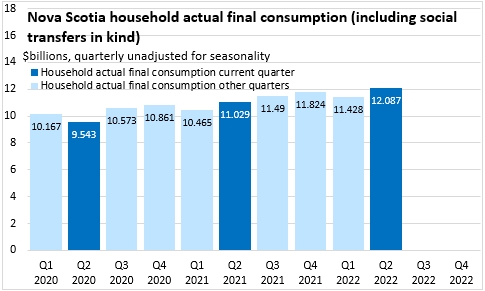
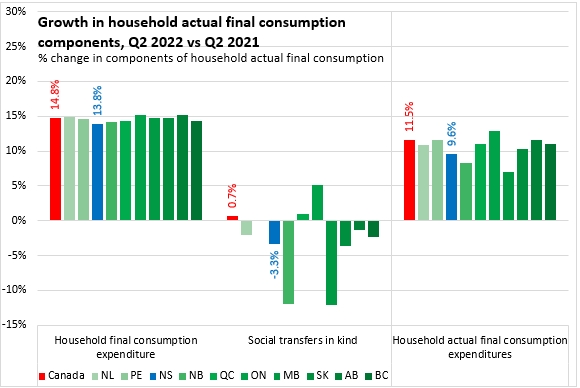
Household net savings (which includes changes in pension entitlements) increased during the pandemic. These effects appear to have been temporary and savings are returning to prior trends. After saving an average of $215 per household in Q2 2021, Nova Scotia's net savings per household were -$1,761 in Q2 2022. All provinces except Ontario and Quebec reported negative net household savings in Q2 2022.
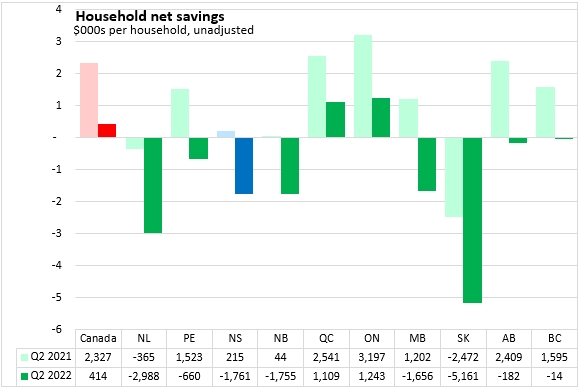
Household actual final consumption expenditures per household in Nova Scotia increased by 3.3% from Q2 2021 to Q2 2022. Growth was fastest for food/accommodation services, clothing/footwear and transportation. Average expenditures on finance/insurance products, alcohol/tobacco and communications were down, as were social transfers in kind for both health and education.
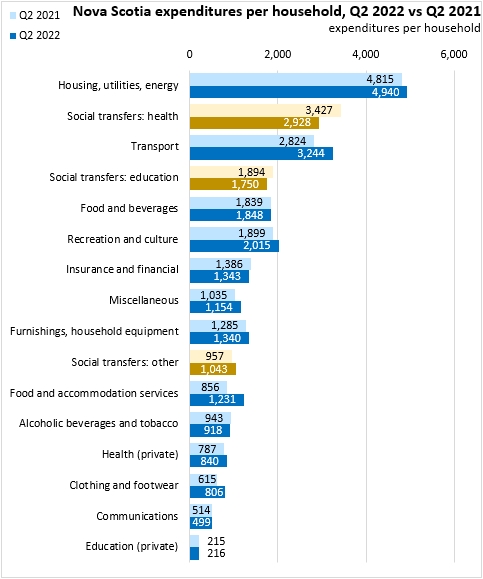
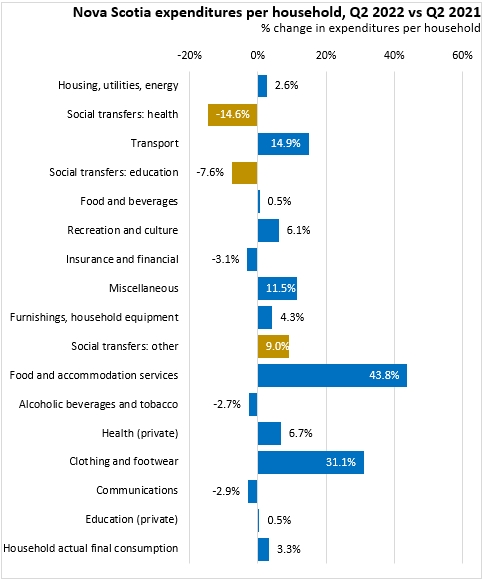
Notes: As part of its new quarterly data for Distribution of Household Economic Accounts, Statistics Canada is now providing quarterly data on household income, household final consumption expenditures and household wealth. This information is available for provinces as well as for income quintiles and age groups.
These quarterly results supplement previously-available provincial data for compensation of employees and investment in fixed capital stock. These concepts align with the Provincial and Territorial Economic Accounts, but they remain subject to revision in future releases.
Source: Statistics Canada. Table 36-10-0663-01 Distributions of household economic accounts, income, consumption and saving, Canada, provinces and territories, quarterly (x 1,000,000)
<--- Return to Archive